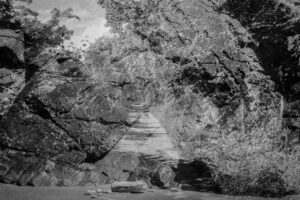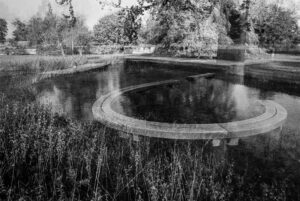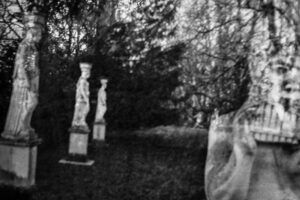Readers who know a bit about photography (and maybe some who don’t) will have realised that the photographs I used in the Traces of Erewhon book project were made using double exposures (see post 19th January 2023). The images were made directly onto film in a camera. Analog photography is always a bit of a gamble, other than in the most controlled conditions; to shoot double exposures lengthens the odds against success considerably, as there is no way to know in advance how the two images will interact in the same frame. However, I was determined to use this technique for the project and decided it was an opportunity to experiment (play might be a better term) with new ways of working.
My aim was to illustrate the text with images of dreamlike, imaginary, disconnected places, so seascapes, landscapes and townscapes were the staring points for subjects. I wanted monochrome pictures and chose Ilford FP4 and HP5 35 mm film stock; and I used four cameras, Contax T2, Leica M6, Nikon FM2 and Olympus Trip. Only the Nikon has a double exposure facility, use of the other three required the film to be reloaded for the second exposure (I always used only two exposures). On one roll of film exposures were made on different days in two different cameras (M6 and T2).
Layering two images gave the option of combining time and place in different ways. I used the following combinations: both exposures on the same day at the same location; both exposures on the same day at different locations; and exposures made on different days at different locations. Exposures were hand held. I used eleven and a half rolls of film, 411 frames.
I’ve assessed the outcome of these experiments against the 26 image used in Traces of Erewhon. However, in some ways this does not necessarily provide a fair reflection of the results as I chose those images that suited my purposes, while knowing that there were other interesting images that I rejected. So, what did I learn?
- Something fundamental that should have been obvious from the start: it’s impossible to combine high key and low key images, light/highlight areas overpower the darks/shadows often leaving not even a ghost image, large areas of bright sky were particular problem.
- Technically, frame registration could be an issue, especially with the Olympus Trip, but with care the errors were relatively minor. (An exception: combining the M6 and T2 resulted in the two images being recorded at 180 degrees to each other, i.e. one upside down to the other, due to the two cameras loading film in different ways!)
- Mixing two images successfully meant holding in the mind’s eye where the component parts of the image would fall in the second exposure. This was clearly much easier to do when the exposures were made on the same occasion of the same subject. In view of this it’s not surprising that using the Nikon FM2 with its double exposure facility at one location on one occasion gave more predictable results and a higher success rate. (Using a tripod with medium and large format cameras and marking up frames would make this much simpler.)
- The power of serendipity! Thirteen of the images in in Traces of Erewhon were made with the ContaxT2; the two sets of exposures on all of the four films from which they were chosen were made on different days; and eight of the successful images were made by combining exposures made at different places. They were not quite happy accidents because the exposures were made deliberately with a particular objective in mind, i.e. the creation of an imaginary place, but they do show the creativity of chance.
The strangeness of Samuel Butler’s Erewhon, a place that was both like and not like anything we might know, was the starting point for this project. From that came the idea to playing with mixing two visual images, often no more than impressions, belonging to different times and places. At its best the magic of photography resulted in the creation of something new and elusive. The possibilities are endless.
The images in this post were not used in Traces of Erewhon.
I could have achieved similar effects by using layers in Photoshop, as Roy Hammans has pointed out. I’ve never used Photopshop, but I suppose if I’d thought about it I would have guessed it could be used as I know about layers. However, I think the joy of analog serendipity would be lost; and anyway that approach sounds more like graphic design than photography.





This was very interesting Brian. Given my response to Traces of Erewhon, where as I mentioned I had trouble reconciling the images and text (probably because I’m unfamiliar with the book). Many of the pictures you did use were fascinating, doubly so (no pun intended) now that I read how you did them! To use four different cameras and film is a remarkable achievement, I’d have been sorely tempted to use digital and layering in Photoshop!
The four used in this article definitely sit with the best examples from the book and evoke mysteries all of their own as stand-alone pictures. Well done!
Thanks, Roy, I’m pleased it made things a little clearer and a bit more meaningful.
I’ve never used Photopshop, but I suppose if I’d thought about it I would have guessed it could be used as I know about layers. However, I think the joy of analog serendipity would be lost; and anyway that approach sounds more like graphics than photography.
I shall make a small edit to the original post to mention the Photoshop alternative.
Best wishes,
Brian